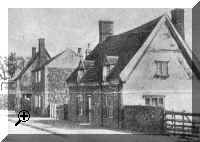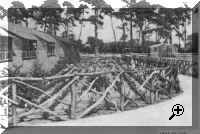The Second World War
In August 1939 Tuddenham village school log book shows that the school
children had already begun to prepare for the outbreak of war. Air raid masks
were tried on, evacuees admitted and windows covered with anti-splinter.
A decoy airfield on a site south of Cavenham operated during 1940/41 to draw
enemy attacks away from Mildenhall. Wooden planes and fake runway lights were
used to confuse the Germans. The ploy worked as German bombers machine gunned
the wooden planes and villagers listening to Lord Haw Haw broadcasting on the
wireless that evening heard him gloating that Mildenhall base had been hit.
 In
the early hours of September 24th.1940 three bombs fell on the village. Two fell
on sandy soil causing little damage but the third fell in the main street
causing a hole according to the locals ' so big you could get a double decker
bus into it'. A cottage and the chapel were so badly damaged that they had to be
demolished. Mr. and Mrs. W. Carter and their four daughters crawled out of the
bombed building covered in soot but unhurt.
In
the early hours of September 24th.1940 three bombs fell on the village. Two fell
on sandy soil causing little damage but the third fell in the main street
causing a hole according to the locals ' so big you could get a double decker
bus into it'. A cottage and the chapel were so badly damaged that they had to be
demolished. Mr. and Mrs. W. Carter and their four daughters crawled out of the
bombed building covered in soot but unhurt.
Working parties were set up in the village to send gifts and clothing to the
forces. In the first three months they had sent 16 knitted helmets, 10 pairs of
socks, 4 pairs of gloves, 39 scarves, 2 pullovers, 2 pairs of mittens, 7 pairs
of oversocks, 2 nightdresses, and 2 pairs of pyjamas to the services .
A Women's Institute was formed and the village women taught how to make jam,
bottle fruit, mend clothes, collect salvage and cook healthy, tasty meals
although essential ingredients were rationed
.
A Women's Institute was formed and the village women taught how to make jam,
bottle fruit, mend clothes, collect salvage and cook healthy, tasty meals
although essential ingredients were rationed .
.
In May 1941 the village held a war weapons week which closed on Saturday
night with a display on the village green by the Fire Brigade, Specials, Wardens
and the A.R.P. services. On Sunday morning led by Newport's Band from Fordham
and headed by the Home Guard they paraded from the white Hart through the
village and back to the church. In October 1943 a new standard 3 runway airfield
opened at Tuddenham. Built on Cavenham Heath by Taylor Woodrow it had Fog
Intensive Dispersal Operation (F.I.D.O.) installed in 1944 and was operational
until 1946. At its peak there were 1,650 station personnel on the books billeted
on a domestic site separated from the main base by the public road .
.
Stirling III's flown by 90th. Bomber Squadron commenced mining operations on
October 17th. 1943. Leaflet raids and S.O.E. sorties were also carried out from
the base. In May 1944 the Stirlings were replaced by Lancaster III's that flew
by day and night against strategic and tactical battle targets .
.
 Tuddenham
village Post Office sent camp personnel for board and lodgings to any villager
who had room to spare and so on January 28th. 1944, Eve Greenwood, a W.A.F. from
Canada, was lodging with Mr. and Mrs. F. Cook at 60, The Street, Tuddenham. Her
Australian husband Johnny, a Pilot Officer, was on duty that night laying mines
in the Kiel Canal. Eve was expecting their first child. Villagers working on the
base were the first to realise that Johnny Greenwood's plane had failed to
return. The camp Padre was called upon to break the news to his wife and
villagers still recall the sorrow of the occasion.
Tuddenham
village Post Office sent camp personnel for board and lodgings to any villager
who had room to spare and so on January 28th. 1944, Eve Greenwood, a W.A.F. from
Canada, was lodging with Mr. and Mrs. F. Cook at 60, The Street, Tuddenham. Her
Australian husband Johnny, a Pilot Officer, was on duty that night laying mines
in the Kiel Canal. Eve was expecting their first child. Villagers working on the
base were the first to realise that Johnny Greenwood's plane had failed to
return. The camp Padre was called upon to break the news to his wife and
villagers still recall the sorrow of the occasion.
 Of
all the flying units stationed at Tuddenham 90 Bomber Squadron had the longest
and closest links with the village and in 1979 formed an association to keep in
contact with each other by means of an annual reunion in the village until 1999
when the group disbanded. The memorial on the village green was donated by the
squadron in 1982.
Of
all the flying units stationed at Tuddenham 90 Bomber Squadron had the longest
and closest links with the village and in 1979 formed an association to keep in
contact with each other by means of an annual reunion in the village until 1999
when the group disbanded. The memorial on the village green was donated by the
squadron in 1982.
In 1954 the airbase passed to the U.S.A.F. until 1959. Thor Missiles were
then installed until 1963 after which the site was abandoned.
©2000 Susan Cook